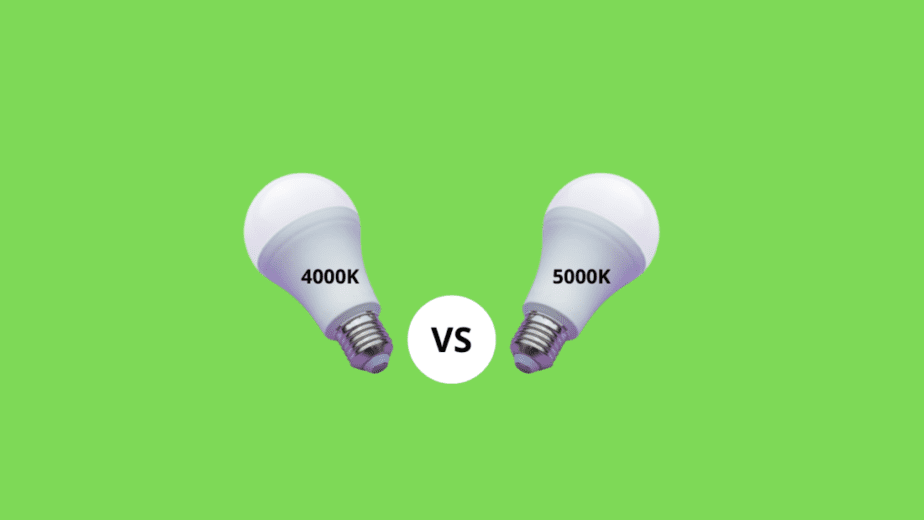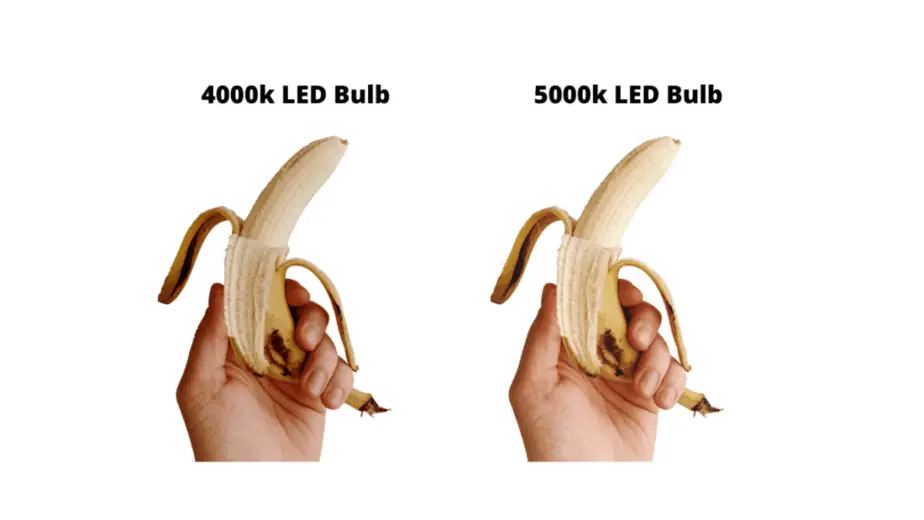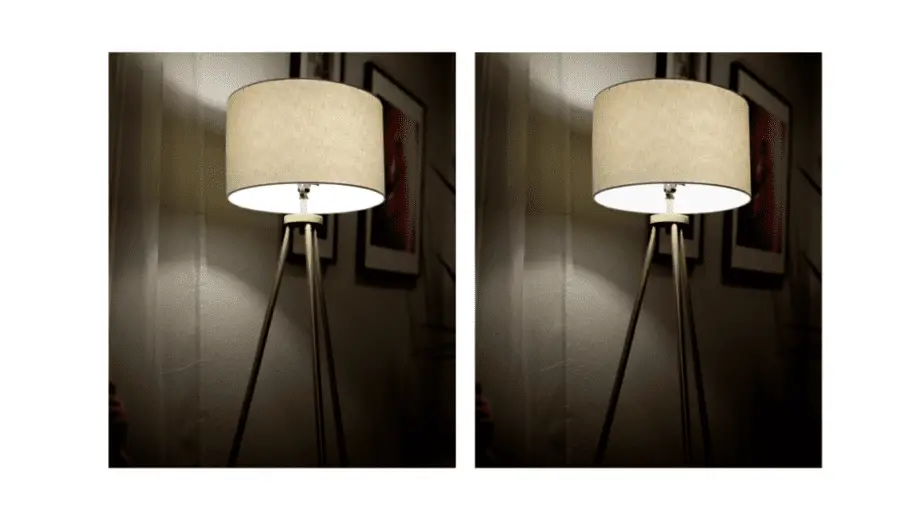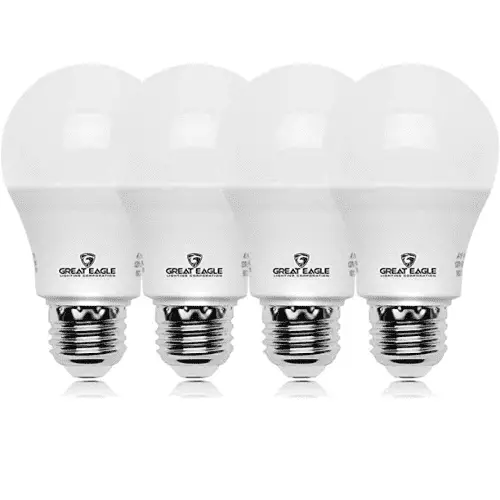4000K vs 5000K LED Light Color Temperature. While setting up a kitchen or an office lighting project, color temperature becomes an issue of taste. LED light colors have more implications other than just aesthetics. The color preference changes according to your application. LEDs come with kelvin numbers, such as 4000K, where the higher the number, the brighter and white the light becomes.
You might be inclined to pick a milder LED light color temperatures for the interior of your kitchen or living room and bright white color that mimics daylight in your study. At first glance, someone may fail to take notice of the difference between a 4000K light and a 5000K light . Nevertheless, it all comes down to your own taste. But you also have to take into account a set of variables that come to play when you are choosing your LED.

4000K vs 5000K LED Light Bulb
A light bulb with a 4000K rating will give you a cool and bright color temperatures with an effect of warmth as well as you will be able to work beneath that light. 5000K lights are bright and white, which feels like natural light, and you can put them in your study, washrooms, and even in the kitchen if needed. Let us see what we can find from a test conducted to see the difference between 4000K and 5000K LED light bulbs.
Testing Bulbs
4000K Bulb
While testing with a 60-watt, 750 lumens 4000K bulb, we saw that the objects around the light are less prominent. In addition, a 4000K LED light color is universal since it is not too warm or too cool, its natural light.

5000K Bulb
A 5000K LED light with the same lumen and watt rating had a whiter and cooler color color temperatures on the surrounding objects. This made us feel that you can easily use this light for kitchen applications or where you’ll be working or studying. The difference between 4000K and 5000K is nuanced but not entirely unnoticeable.

Is There a Difference Between 4000K and 5000K Lighting?
You cannot differentiate between LED light colors of 4000K and 5000K bulbs at first glance. No one should expect to bring a photometer to test the exact value of the Kelvin scale in the store. That is where we come in. We can tell you that if you are exposed to these lights for a while, you will start to notice the little differences that make a choice between these two bulbs crucial.
When you observe the light of a 4000K light without ever knowing about the 5000k one, it would seem to you that 4000K is the whitest light on the market. But this light has a slight touch of yellow that makes it mellow on the eyes. So, you can use this light for general purpose applications.
After being in 4000K lights, when you will observe 5000K ones, you will find out that it has no trace of yellow light and will seem like an absolute white light. This light will help you to see the real color temperatures of objects. They are mostly found in art museums, galleries, studios, and in some study or work areas.

Is 5000K Better Than 4000K In Terms of Brightness?
If we consider only the Kelvin scale, it cannot be said that 4000K lights are too bright or vice versa. LED light color and color temperatures are not analogous terms. We use lumen as an indicator of brightness which is dependent on wattage. Both 5000K and 4000K lights can come in a diverse range of wattage.
Now, a 5000K bulb with 60-watt can have 750 lumens, while another 4000K bulb can have the same brightness ratings. It is now clear that a 4000K bulb and a 5000K bulb with the same lumen rating can cover a particular area equally in terms of brightness. So, we cannot say 5000K lights are brighter than 4000K ones. The difference comes from the presence of a tinge of yellow in 4000K bulbs.

4000K LED Light Bulb
4000K bulbs fall in-between “warm white” light of 2700K to 3000K bulbs and “daylight white” of 5000K bulbs. When you compare it with warm white lights, it will appear to be cool, but not as cool as 5000K ones.
These lights are widely used in retail shops, markets, and office spaces as it replicates the sunlight of morning or afternoon hours. Office workers feel energized and at the same time, their eyesights are protected from too much exposure to intense light.
5000K LED Light Bulb
While 4000K lights bring a morning or afternoon vibe, 5000K is that of a mid-day light with a clear sky. This light is devoid of any yellowish tinge and gives a clear view of everything in its range. As a result, you will see them used in art galleries, task-specific workstations, and study areas. Some tasks will require you to have tight focus, and these lights will not let you get dizzy. An excellent feature of 5000K light is that it provides a compromise between losing color acuity at lower temperature lights (2700K) and high intensity of blue hint present in higher temperature ones (6500K).

Where To Use 4000K. 4000K vs 5000K LED Light Color Temperature
Light and circadian rhythm that governs human bodies go hand in hand. The intensity and color temperatures of indoor lighting effects our brains. 4000K lights provide the sweet spot for us to gain optimum performance in our work. For this reason, the lighting of places where people spend a lot of time is on the warmer side (4000K).
Office spaces utilize this circadian lighting style and use 4000K lighting so that employees stay on full alert the entire day. At the same time, the 4000K LED color temperature is warmer, so they don’t feel stressed out from the continuous exposure.
4000K lights are widely used in retail since they don’t seem too sterile in low-sunlight hours. The color clarity that comes with these lights make products seem more lively and real to the audience.
You will need crisp and fresh lighting in the garage or workshop to see the tools clearly and avoid mishaps. A clean light such as the 4000K will make your life easier without overstraining your eyes.
The ideal color temperature between soft white and daylight. Equivalent 60-watt bulb with 750 lumens.
Where To Use 5000K. 4000K vs 5000K LED Light Color Temperature
5000K LED Light Color Temperature are used where color correctness is of utmost importance. In addition, professional workspaces that are sophisticated in nature always use 5000K LED Light Color Temperature bulbs.
The regulatory bodies have mandated the use of 5000K LED Light Color Temperature lights in warehouses since the workers need to be in their highest alert state. Also, this light provides proper visibility so that workers can avoid accidents and do their jobs properly. It is crucial to have adequate and crisp lighting in warehouses, and that is where 5000K lights come in.
Stadiums use 5000K LED Light Color Temperature lights for correct lighting for high-resolution broadcasting. High-definition cameras can capture split-second moments in such LED lighting.
5000K LED Light Color Temperature lights are widely used in hospitals for check-ups and surgery purposes since the doctors need to see their apparatus and patients as clearly as possible to perform their duties accurately.
Galleries that are displaying artworks or artifacts utilize 5000K LED Light Color Temperature lights so that the object of attention can convey its full details to the viewer. Moreover, stage theaters also use these lights to provide clear visibility to the audience.
Philips – Hign Lumen 5000K LED Bulb
Non-Dimmable A19 Frosted Light Bulbs uses 80% less energy than 100 Watt Incandescent Bulbs.
4000K vs 5000K LED for Kitchen. 4000K vs 5000K LED Light Color Temperature
The architecture and interior of your kitchen play a vital role in the selection between 4000K and 5000K. If you are using white cabinets and modern interior design, we suggest going with 5000K LED Light Color Temperature. 4000K LED Light Color Temperature lights can give an unwanted pink shade to white furniture for its warmth.
Kitchens with traditional wood color furniture are ideal for 4000K LED Light Color Temperature lights. It will complement the overall tone of the kitchen.
Both 4000K and 5000K lights will give enough brightness for you to do culinary work. It all comes down to how your LED light color preference and what you perceive to be soothing to your eyes.
Read also: What Is the Best LED Light Color for Studying
FAQ: 4000K vs 5000K LED Light Color Temperature
Is 4000K or 5000K better?
The choice between 4000K and 5000K color temperatures for lighting often depends on personal preference and the setting. Generally, 4000K tends to offer a slightly warmer, more relaxed ambiance, while 5000K leans toward a cooler, brighter, and more energetic feel.
What is the benefit of 5000K light?
5000K color temperatures light is often preferred for spaces where crisp, clear illumination is crucial, like work environments or areas requiring detailed tasks. It mimics natural daylight, enhancing focus, alertness, and color rendering, making it suitable for productivity and precision.
Is 5000K better for your eyes?
The brightness and color temperature of 5000K color temperatures may cause less strain on the eyes compared to warmer tones like 2700K or 3000K, especially for reading or tasks requiring focus. However, individual preferences and sensitivities vary, so what works best can differ from person to person.
Which is better 4000K or 6500K?
The choice between 4000K and 6500K depends on the setting and the ambiance you prefer. 4000K provides a balanced light, suitable for both task-oriented and ambient settings, while 6500K emits a cooler, bluish light often preferred in areas requiring high visibility or to simulate daylight.
Conclusion: 4000K vs 5000K LED Light Color Temperature
4000K vs 5000K LED Light Color Temperature. Choosing the right LED light color for your kitchen, office, or workspace is crucial for aesthetics and overall productivity. 4000K and 5000K lights do not differ significantly in brightness; rather, it is a matter of color toning. You might not even notice the difference at first.
As 5000K is higher on the Kelvin scale, it is whiter and sharper compared to the mild, slight yellowish 4000K. Both have their places and make sure you use the right one for your desired application.
when you compare it with a 5000K light, you will see that 4000K has a warmer color temperature that gives a slight yellowish hue to the light. Whereas 5000K has a neutral white color that is closer to the true color of the light source.
The color temperature of a light is measured in Kelvin (K), which is a temperature scale that ranges from 1000K to 10000K. The lower the Kelvin number, the warmer and more yellow the light is. The higher the Kelvin number, the cooler and more blue the light is. The color of the light affects how we perceive the color of the objects that are illuminated by it. For example, a red apple will look more orange under a warm light, and more purple under a cool light.
Different color temperatures create different moods and atmospheres in a room. A warm color temperature (between 2700K and 3000K) is cozy, relaxing, and inviting. It is suitable for living rooms, bedrooms, and dining rooms. A neutral color temperature (between 4000K and 4500K) is balanced, clear, and comfortable. It is suitable for kitchens, bathrooms, and offices. A cool color temperature (between 5000K and 6500K) is bright, crisp, and energizing. It is suitable for garages, workshops, and studios.
Choosing the right color temperature for your LED light depends on your personal preference, the purpose of the room, and the time of the day. Some general guidelines are:
- Use warm color temperatures for spaces where you want to create a cozy and relaxing ambiance, such as living rooms, bedrooms, and dining rooms. Warm lights are also good for evening and night time, as they help you wind down and prepare for sleep.
- Use neutral color temperatures for spaces where you need clear lighting without any blue or yellow tint, such as kitchens, bathrooms, and offices. Neutral lights are also good for morning and afternoon, as they help you wake up and stay alert.
- Use cool color temperatures for spaces where you need bright lighting to see details and colors accurately, such as garages, workshops, and studios. Cool lights are also good for daytime, as they mimic natural light and boost your mood and energy.
You can also change the color temperature of your LED light according to your needs and preferences. Some LED lights have adjustable color temperatures, which allow you to switch between warm, neutral, and cool modes. Some LED lights have dimmable features, which allow you to gradually increase or decrease the temperature and brightness of the light. Some LED lights have smart features, which allow you to control the color temperature and other settings with your smartphone or voice assistant.
4000K vs 5000K LED Light Comparison To help you decide between 4000K and 5000K LED lights, here are some examples of how they look and feel in different settings and applications.
- Outdoor lighting: Both 4000K and 5000K LED lights are suitable for outdoor lighting, as they provide clear and bright lighting that enhances security and visibility. However, 5000K LED lights may be preferred for areas where you need to see colors and details more clearly, such as driveways, pathways, and gardens. 4000K LED lights may be preferred for areas where you want to create a more warm and inviting atmosphere, such as porches, patios, and decks.
- Cabinet lighting: Both 4000K and 5000K LED lights are suitable for cabinet lighting, as they provide ambient lighting that highlights your cabinets and countertops. However, 5000K LED lights may be preferred for cabinets that have cool or neutral colors, such as white, gray, or blue. 4000K LED lights may be preferred for cabinets that have warm or earthy colors, such as brown, beige, or red.
- Office lighting: Both 4000K and 5000K LED lights are suitable for office lighting, as they provide proper lighting that helps you work efficiently and comfortably. However, 5000K LED lights may be preferred for offices that need high color representation and accuracy, such as galleries, studios, and design firms. 4000K LED lights may be preferred for offices that need balanced and comfortable lighting that reduces eye strain and fatigue, such as law firms, accounting firms, and medical offices.
Read also: 3000K vs 4000K – What’s The Actual Difference?

My strong expertise is illuminating spaces. With a keen eye for detail and a passion for transforming environments through lighting, my dream is to leave indelible mark on the world of light design. Below are few facts of my biography, highlighting career and hobbies. Click here to contact me.


